Tsvetomila Mihaylova
Instituto de Telecomunicações, Lisbon, Portugal
Do Visual-Language Maps Capture Latent Semantics?
Mar 15, 2024Abstract:Visual-language models (VLMs) have recently been introduced in robotic mapping by using the latent representations, i.e., embeddings, of the VLMs to represent the natural language semantics in the map. The main benefit is moving beyond a small set of human-created labels toward open-vocabulary scene understanding. While there is anecdotal evidence that maps built this way support downstream tasks, such as navigation, rigorous analysis of the quality of the maps using these embeddings is lacking. We investigate two critical properties of map quality: queryability and consistency. The evaluation of queryability addresses the ability to retrieve information from the embeddings. We investigate two aspects of consistency: intra-map consistency and inter-map consistency. Intra-map consistency captures the ability of the embeddings to represent abstract semantic classes, and inter-map consistency captures the generalization properties of the representation. In this paper, we propose a way to analyze the quality of maps created using VLMs, which forms an open-source benchmark to be used when proposing new open-vocabulary map representations. We demonstrate the benchmark by evaluating the maps created by two state-of-the-art methods, VLMaps and OpenScene, using two encoders, LSeg and OpenSeg, using real-world data from the Matterport3D data set. We find that OpenScene outperforms VLMaps with both encoders, and LSeg outperforms OpenSeg with both methods.
Discrete Latent Structure in Neural Networks
Jan 18, 2023


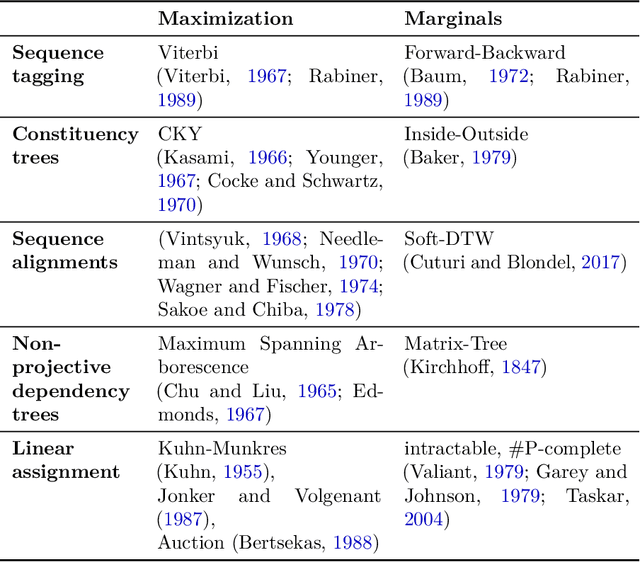
Abstract:Many types of data from fields including natural language processing, computer vision, and bioinformatics, are well represented by discrete, compositional structures such as trees, sequences, or matchings. Latent structure models are a powerful tool for learning to extract such representations, offering a way to incorporate structural bias, discover insight about the data, and interpret decisions. However, effective training is challenging, as neural networks are typically designed for continuous computation. This text explores three broad strategies for learning with discrete latent structure: continuous relaxation, surrogate gradients, and probabilistic estimation. Our presentation relies on consistent notations for a wide range of models. As such, we reveal many new connections between latent structure learning strategies, showing how most consist of the same small set of fundamental building blocks, but use them differently, leading to substantially different applicability and properties.
Modeling Structure with Undirected Neural Networks
Feb 08, 2022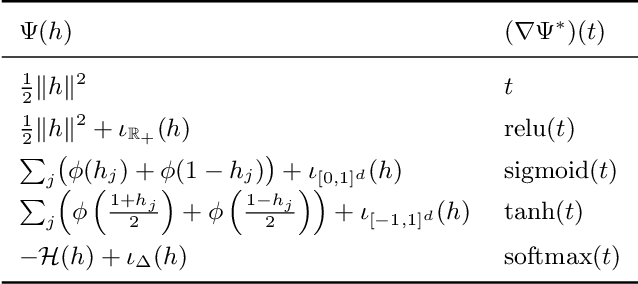
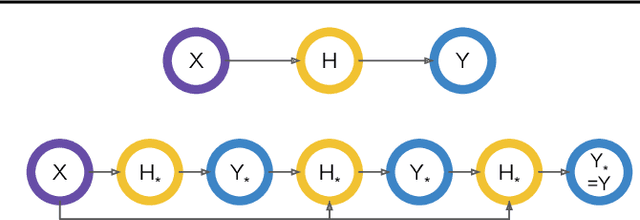
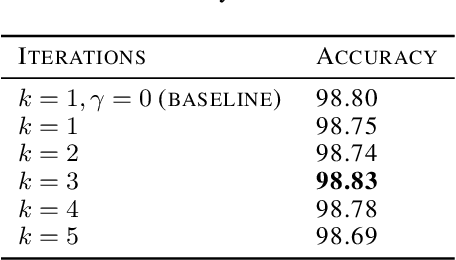
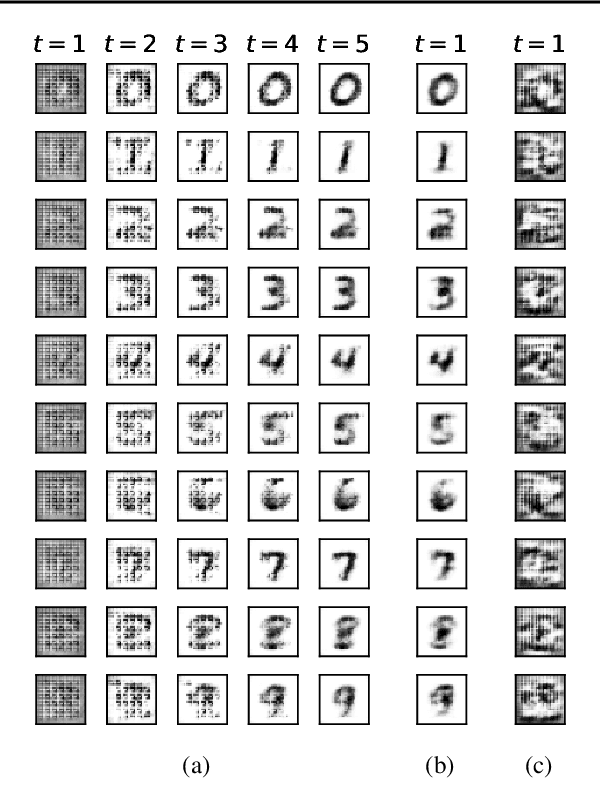
Abstract:Neural networks are powerful function estimators, leading to their status as a paradigm of choice for modeling structured data. However, unlike other structured representations that emphasize the modularity of the problem -- e.g., factor graphs -- neural networks are usually monolithic mappings from inputs to outputs, with a fixed computation order. This limitation prevents them from capturing different directions of computation and interaction between the modeled variables. In this paper, we combine the representational strengths of factor graphs and of neural networks, proposing undirected neural networks (UNNs): a flexible framework for specifying computations that can be performed in any order. For particular choices, our proposed models subsume and extend many existing architectures: feed-forward, recurrent, self-attention networks, auto-encoders, and networks with implicit layers. We demonstrate the effectiveness of undirected neural architectures, both unstructured and structured, on a range of tasks: tree-constrained dependency parsing, convolutional image classification, and sequence completion with attention. By varying the computation order, we show how a single UNN can be used both as a classifier and a prototype generator, and how it can fill in missing parts of an input sequence, making them a promising field for further research.
SUper Team at SemEval-2016 Task 3: Building a feature-rich system for community question answering
Sep 26, 2021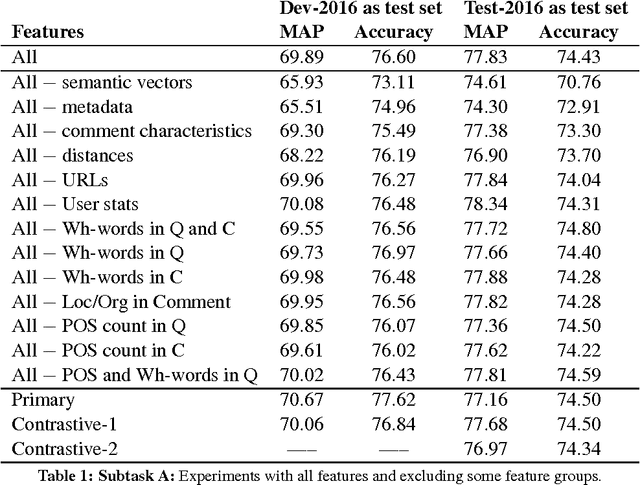
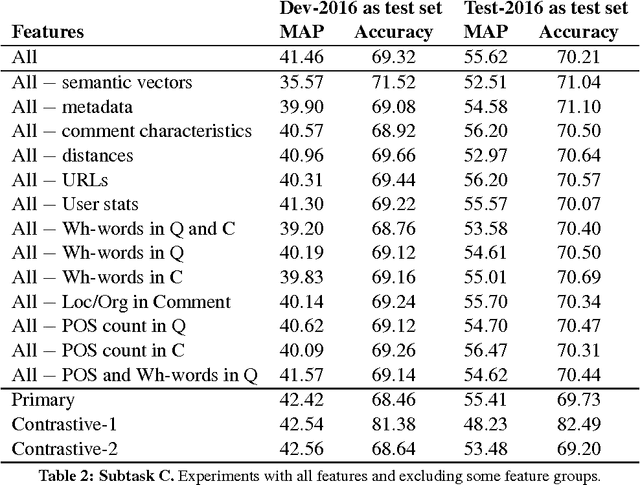

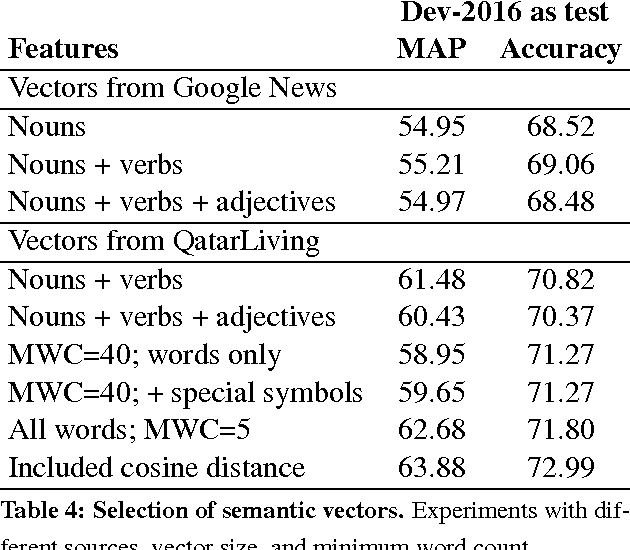
Abstract:We present the system we built for participating in SemEval-2016 Task 3 on Community Question Answering. We achieved the best results on subtask C, and strong results on subtasks A and B, by combining a rich set of various types of features: semantic, lexical, metadata, and user-related. The most important group turned out to be the metadata for the question and for the comment, semantic vectors trained on QatarLiving data and similarities between the question and the comment for subtasks A and C, and between the original and the related question for Subtask B.
* community question answering, question-question similarity, question-comment similarity, answer reranking
Understanding the Mechanics of SPIGOT: Surrogate Gradients for Latent Structure Learning
Oct 05, 2020



Abstract:Latent structure models are a powerful tool for modeling language data: they can mitigate the error propagation and annotation bottleneck in pipeline systems, while simultaneously uncovering linguistic insights about the data. One challenge with end-to-end training of these models is the argmax operation, which has null gradient. In this paper, we focus on surrogate gradients, a popular strategy to deal with this problem. We explore latent structure learning through the angle of pulling back the downstream learning objective. In this paradigm, we discover a principled motivation for both the straight-through estimator (STE) as well as the recently-proposed SPIGOT - a variant of STE for structured models. Our perspective leads to new algorithms in the same family. We empirically compare the known and the novel pulled-back estimators against the popular alternatives, yielding new insight for practitioners and revealing intriguing failure cases.
Automatic Fact-Checking Using Context and Discourse Information
Aug 04, 2019



Abstract:We study the problem of automatic fact-checking, paying special attention to the impact of contextual and discourse information. We address two related tasks: (i) detecting check-worthy claims, and (ii) fact-checking claims. We develop supervised systems based on neural networks, kernel-based support vector machines, and combinations thereof, which make use of rich input representations in terms of discourse cues and contextual features. For the check-worthiness estimation task, we focus on political debates, and we model the target claim in the context of the full intervention of a participant and the previous and the following turns in the debate, taking into account contextual meta information. For the fact-checking task, we focus on answer verification in a community forum, and we model the veracity of the answer with respect to the entire question--answer thread in which it occurs as well as with respect to other related posts from the entire forum. We develop annotated datasets for both tasks and we run extensive experimental evaluation, confirming that both types of information ---but especially contextual features--- play an important role.
* JDIQ,Special Issue on Combating Digital Misinformation and Disinformation
Scheduled Sampling for Transformers
Jun 18, 2019


Abstract:Scheduled sampling is a technique for avoiding one of the known problems in sequence-to-sequence generation: exposure bias. It consists of feeding the model a mix of the teacher forced embeddings and the model predictions from the previous step in training time. The technique has been used for improving the model performance with recurrent neural networks (RNN). In the Transformer model, unlike the RNN, the generation of a new word attends to the full sentence generated so far, not only to the last word, and it is not straightforward to apply the scheduled sampling technique. We propose some structural changes to allow scheduled sampling to be applied to Transformer architecture, via a two-pass decoding strategy. Experiments on two language pairs achieve performance close to a teacher-forcing baseline and show that this technique is promising for further exploration.
SemEval-2019 Task 8: Fact Checking in Community Question Answering Forums
May 25, 2019

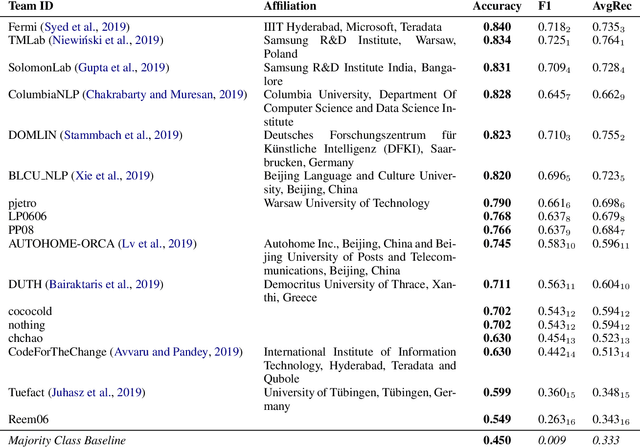
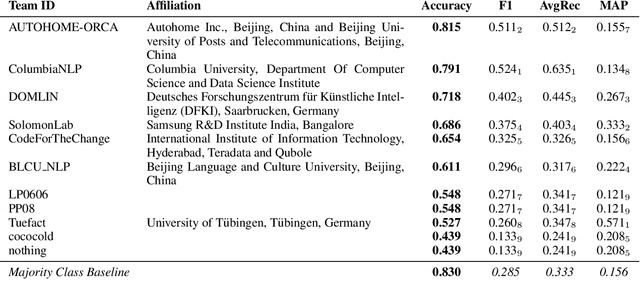
Abstract:We present SemEval-2019 Task 8 on Fact Checking in Community Question Answering Forums, which features two subtasks. Subtask A is about deciding whether a question asks for factual information vs. an opinion/advice vs. just socializing. Subtask B asks to predict whether an answer to a factual question is true, false or not a proper answer. We received 17 official submissions for subtask A and 11 official submissions for Subtask B. For subtask A, all systems improved over the majority class baseline. For Subtask B, all systems were below a majority class baseline, but several systems were very close to it. The leaderboard and the data from the competition can be found at http://competitions.codalab.org/competitions/20022
Fact Checking in Community Forums
Mar 08, 2018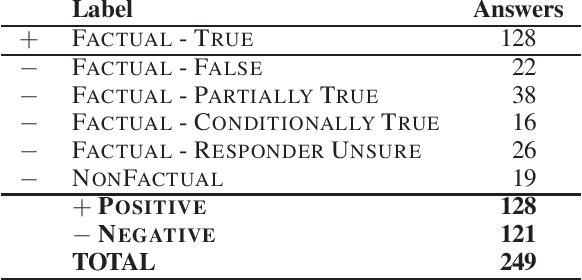
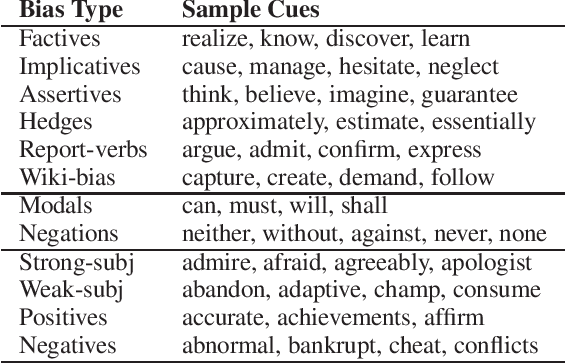
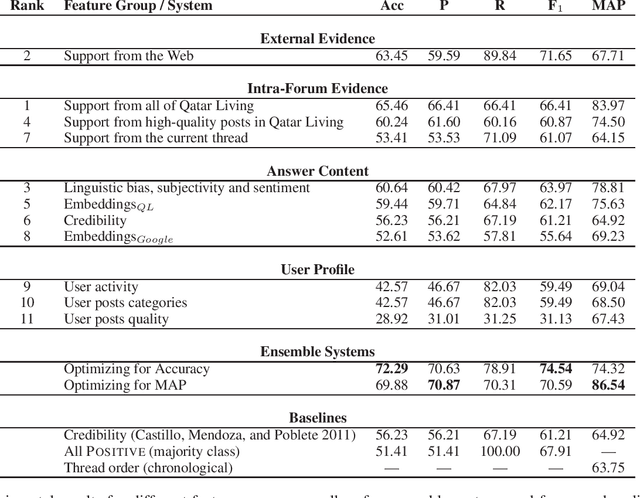

Abstract:Community Question Answering (cQA) forums are very popular nowadays, as they represent effective means for communities around particular topics to share information. Unfortunately, this information is not always factual. Thus, here we explore a new dimension in the context of cQA, which has been ignored so far: checking the veracity of answers to particular questions in cQA forums. As this is a new problem, we create a specialized dataset for it. We further propose a novel multi-faceted model, which captures information from the answer content (what is said and how), from the author profile (who says it), from the rest of the community forum (where it is said), and from external authoritative sources of information (external support). Evaluation results show a MAP value of 86.54, which is 21 points absolute above the baseline.
The Case for Being Average: A Mediocrity Approach to Style Masking and Author Obfuscation
Jul 28, 2017
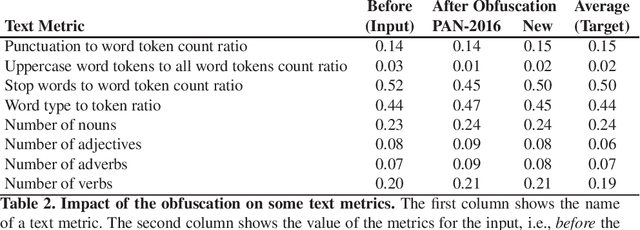
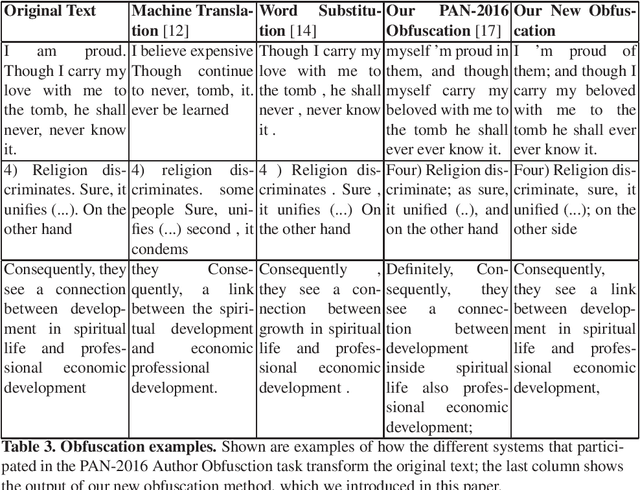
Abstract:Users posting online expect to remain anonymous unless they have logged in, which is often needed for them to be able to discuss freely on various topics. Preserving the anonymity of a text's writer can be also important in some other contexts, e.g., in the case of witness protection or anonymity programs. However, each person has his/her own style of writing, which can be analyzed using stylometry, and as a result, the true identity of the author of a piece of text can be revealed even if s/he has tried to hide it. Thus, it could be helpful to design automatic tools that can help a person obfuscate his/her identity when writing text. In particular, here we propose an approach that changes the text, so that it is pushed towards average values for some general stylometric characteristics, thus making the use of these characteristics less discriminative. The approach consists of three main steps: first, we calculate the values for some popular stylometric metrics that can indicate authorship; then we apply various transformations to the text, so that these metrics are adjusted towards the average level, while preserving the semantics and the soundness of the text; and finally, we add random noise. This approach turned out to be very efficient, and yielded the best performance on the Author Obfuscation task at the PAN-2016 competition.
 Add to Chrome
Add to Chrome Add to Firefox
Add to Firefox Add to Edge
Add to Edge